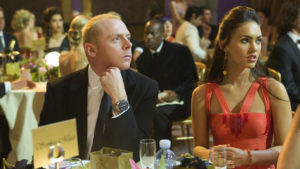2008. 110 min. Rated R.
“So, here I am at the center of everything. I’ve got the tux, I’ve got the watch, I’ve got the life. I’m exactly where I wanted to be.”

In general, Hollywood over-relies on the affirmation story. The gist of it is a charismatic hero whom we already know to be basically admirable, who undergoes a change of opinion or other minor transformation, and then becomes the Chosen One according to the prophecy. Avatar is a good example. I don’t hate affirmation stories per se – the Odyssey is an affirmation story (as are most comics), but I am pretty sick of Avatar and its ilk.
Automatic heroes leave little to think about for either actors or viewers. Because heroism is so easy to swallow, (everyone can relate to the good guy), even shoddily written affirmation tales can bring down huge box office numbers. They’re thought of as “big” movies and get commensurate budgets, actors, and special effects. How to Lose Friends and Alienate People, in contrast, is a small, unassuming film with no heroes, no special effects, and a main character who begins as an asshole and ends as a slightly more self-aware asshole. The fact that the film is basically about celebrity journalism probably helps.
From the very beginning, all moral action is relative to the standard of the tabloids. It’s worth mentioning that this movie is based on a memoir of the same title by Toby Young. How to Lose Friends follows twenty-something celebrity journalist Sidney Young (Simon Pegg), who sells out one piece at a time. First, he abandons his small indie publication for a high-paying insider job, then abdicates his professional integrity in exchange for fame, and even gives away his mother’s wedding ring for an opportunity to sleep with up-and-coming actress Sophie Maes (Megan Fox). Finally, Young realizes he was happier on the outside, and sinks his ship with appropriately public and over-the-top lack of panache. Considering the cast, it seems likely that many characters are played from live subjects. From Jeff Bridges to Megan Fox, almost everyone’s a name. Even A-listers appear – Kate Winslet and Daniel Craig make cameo appearances. All performances are fairly solid, even that of Alison Olsen (Kirsten Dunst). Dunst’s acting talent is clearly challenged by her role, but she hangs in there like a champ.
As usual, Pegg does a fine job playing Sidney Young, the asshole with a heart of gold. Sidney’s trajectory will be intimately familiar to any young person who has ever sold out for a tacit, collectively-implied definition of success after a period of professional arrogance (in other words, 75% of recent college graduates – myself included – will find this character relatable). Sidney’s only weakness lies in his brash young British attitude, which happens to come across as fairly crass to American eyes. For example, he shows up to his first day on the job at a major New York celebrity rag wearing a tee-shirt that declares him “Young, Dumb, and Full of Come.” Even in the Big Apple, this is quite a statement for the workplace.
Slapstick is the film’s other great Achilles heel. While the gags are funny here and there, they mostly just got in the way of more interesting aspects of the plot. Alison’s affair with editor Lawrence Maddox (Danny Huston) got my attention, for example. Here was another character whose moral relativity had been challenged by her surroundings, but the best indication of her distress at her status is a very long drunk scene in which hilarity abounds.
Likewise, I would have been more interested in Sydney’s complicated relationship with his father (Bill Patterson) than I was in Sidney’s shock at having unwittingly brought home a transsexual woman (Charlotte Devaney). I very much appreciated how the small tragedies of the characters were presented in a tasteful and understated fashion. It made a nice in-movie contrast to the obnoxious celebrity gossip trade, implying that part of the film’s message was that being talked about doesn’t necessarily make someone a better person, a more meaningful person, a more interesting person, or more of a person. That’s a potentially deep point. It really got drowned out in the rings stuck on fingers and the dead dogs and the strippers in the workplace.
The final gag in particular cheapens the otherwise charming love story. I find myself wondering how this tale would have been different if it had taken itself slightly more seriously. How to Lose Friends and Alienate People is not destined to be a classic, but it was solid and entertaining. I liked the characters more for their flaws and enjoyed watching the actors delivering on their roles. I recommend it for a rental or Netflix movie night with friends in the industry.
